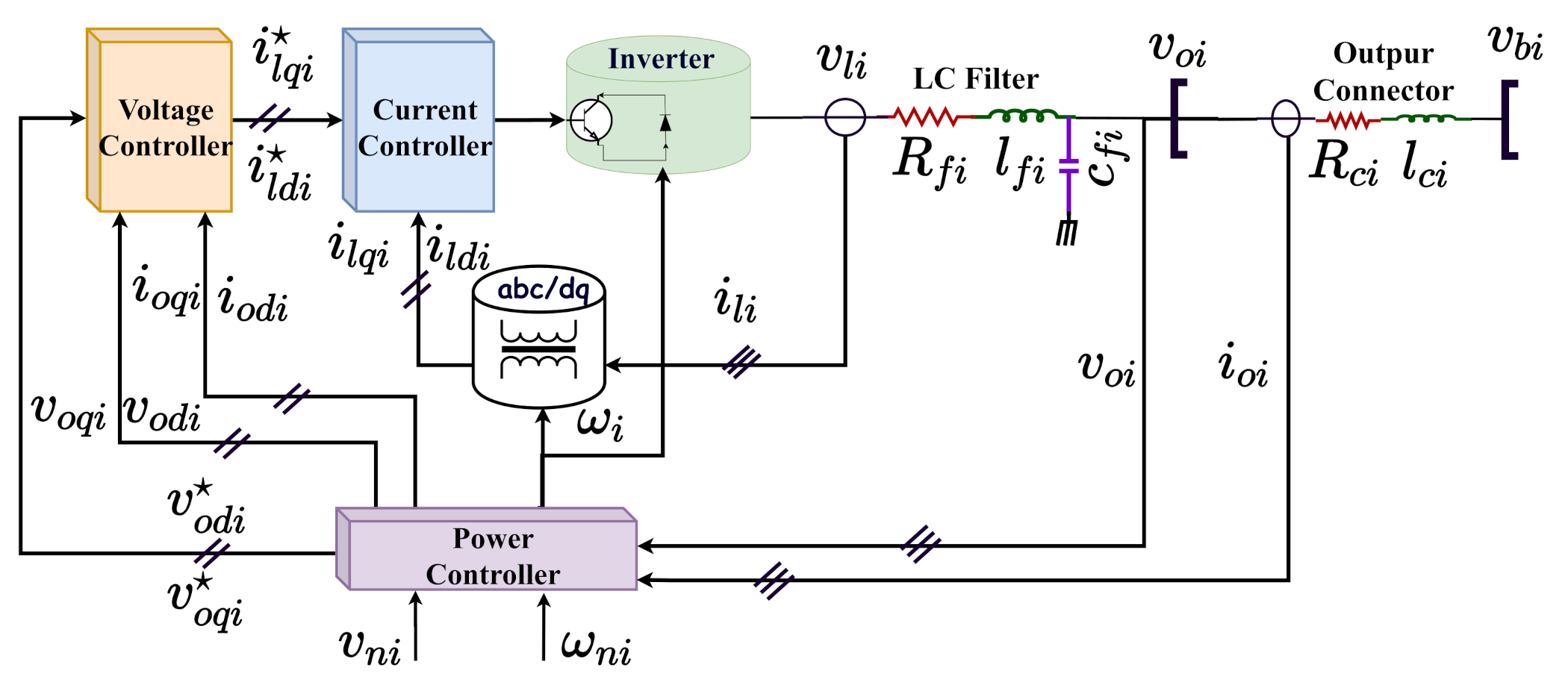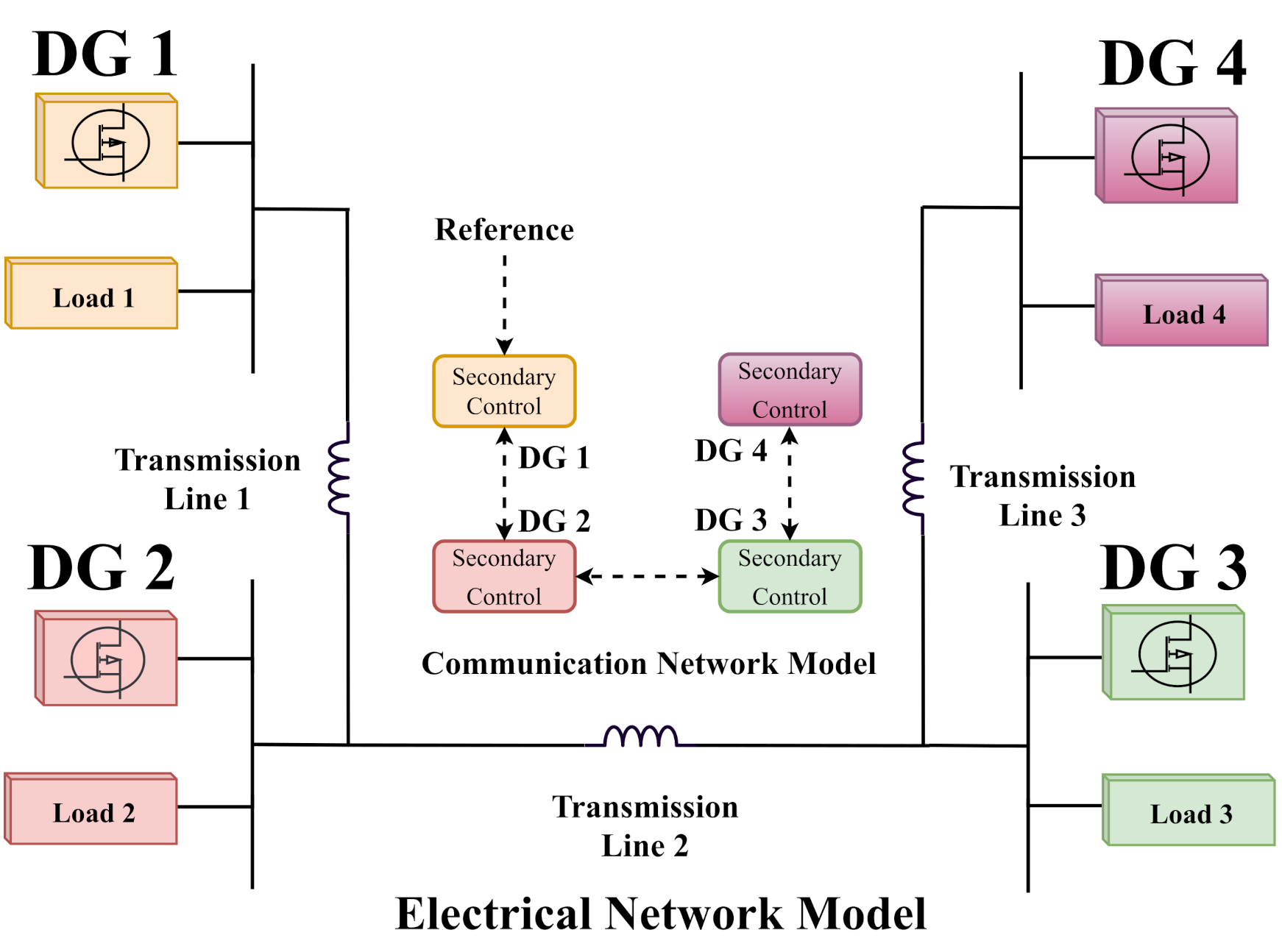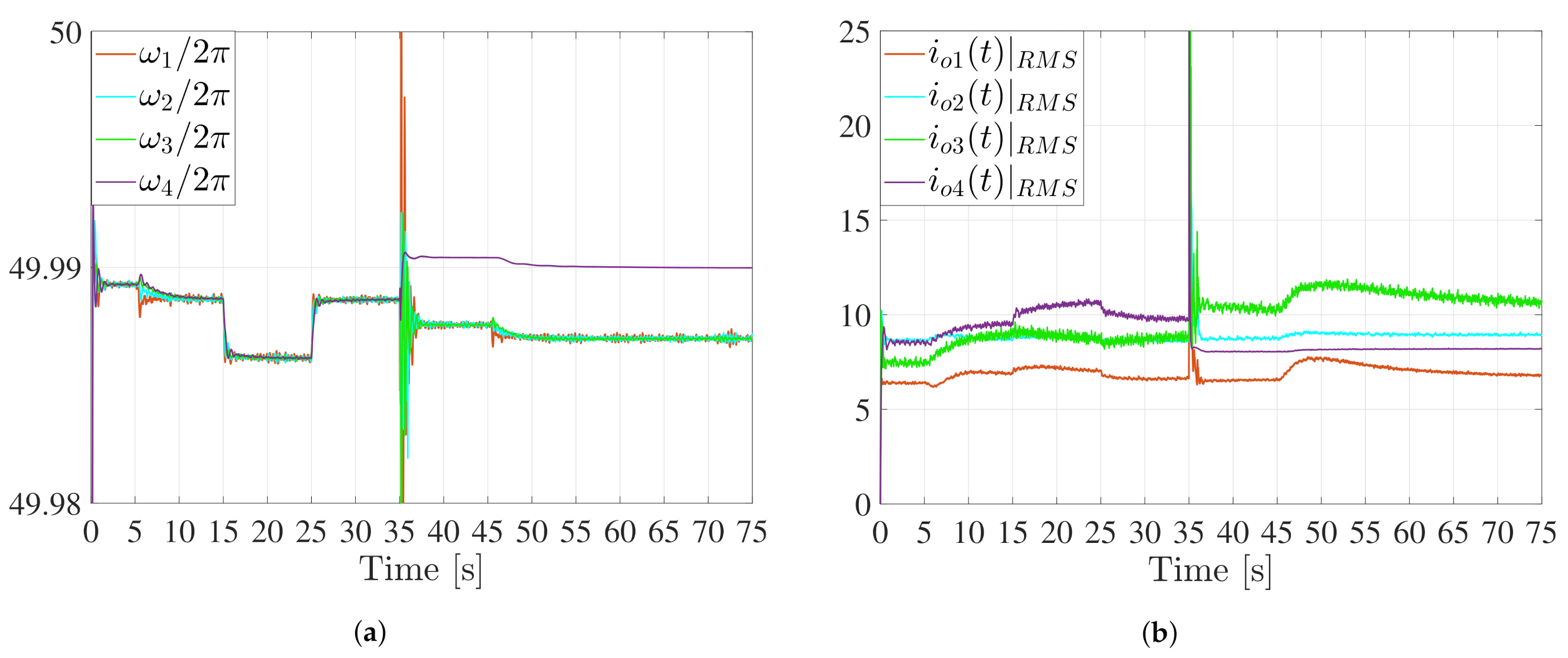Robust Distributed Secondary Voltage Restoration Control of AC Microgrids under Multiple Communication Delays
Abstract
1. Introduction
1.1. Literature Review
1.2. Statement of Contributions
- Here a much more faithful MG modelization expressed in the d-q-reference frame is considered, whereas in our past work DGs were simply modelled as second-order coupled oscillators.
- The tuning criteria in our past work involves non-convex optimization which can thus hardly be solved in practice. On the other hand, our novel Algorithm 1 is based on the solution of a standard LMI problem, solvable by means of standard interior-point solvers.
- Here Lemma 1 proofs that matrix in Algorithm 1 is always negative definite, whereas in our past work this was an operating assumption;
- The proposed control protocol is now tested on a realistic MG model which accounts, along with time-varying delays, 3-phase PWM controlled power bridges, noisy measurements with a realistic Signal-to-Noise Ratio, and unplanned faults.
| Algorithm 1 Tuning algorithm for k in (35). |
(a) Determine ∀l and g the matrices ,
where
(b) Solve for and the positive definite matrices P, , , , , the LMI problem
(c) If the given solution satisfies (3) then: Break Else: EndIf. |
1.3. Paper Organization
1.4. Mathematical Notation
1.5. Nomenclature
- : Speed of the common rotating reference frame
- : Speed of the rotating reference frame of the i-th DG
- : Angle between the local and common reference frames
- : Voltage and frequency secondary control commands;
- : 3-ph voltages and currents at node k of the i-th DG
- : d-q voltages of the i-th DG at node k
- : d-q currents of the i-th DG at node k
- : Denote the input “”, output “” and bus node “”of a DG
- : Desired voltage and frequency secondary restoration values
- : Active and reactive powers dc-components at the output node of the i-th DG
- : d-q voltage set-points of the i-th DG
- : d-q voltage error’s integral of the i-th DG
- : d-q current set-points of the i-th DG
- : d-q current error’s integral of the i-th DG
2. Microgrid (MG) Modeling for Secondary Control Design
MG’s Network Models
3. Voltage Secondary Control Design
4. Results and Discussion
4.1. Test Rig Design
4.2. Voltage Secondary Control Implementation
4.3. Case Study
- Step 1 (): Only the primary control is active with , (per phase rms);
- Step 3 (): An additional load is connected/disconnected at the bus 3;
- Step 4 (): A 3-ph to ground fault occurs on the Line 3;
- Step 5 (): Over-current protection devices isolate Line 3, thus DG4 results electrically isolated;
- Step 6 (): The set-point for the voltage Secondary Control is changed to ;
5. Conclusions
Author Contributions
Funding
Institutional Review Board Statement
Informed Consent Statement
Data Availability Statement
Conflicts of Interest
Appendix A. Graph Theory
Appendix B. Stability of Time-Delay Systems
Appendix C. Proof of Lemma 1
Appendix D. Proof of Theorem 1


References
- Guerrero, J.M.; Vasquez, J.C.; Matas, J.; De Vicuña, L.G.; Castilla, M. Hierarchical control of droop-controlled AC and DC microgrids—A general approach toward standardization. IEEE Trans. Ind. Electron. 2011, 58, 158–172. [Google Scholar] [CrossRef]
- Simpson-Porco, J.W.; Dörfler, F.; Bullo, F. Synchronization and power sharing for droop-controlled inverters in islanded microgrids. Automatica 2013, 49, 2603–2611. [Google Scholar] [CrossRef]
- D’silva, S.; Shadmand, M.; Bayhan, S.; Abu-Rub, H. Towards Grid of Microgrids: Seamless Transition between Grid-Connected and Islanded Modes of Operation. IEEE Open J. Ind. Electron. Soc. 2020, 1, 66–81. [Google Scholar] [CrossRef]
- Lopes, J.P.; Moreira, C.; Madureira, A. Defining control strategies for microgrids islanded operation. IEEE Trans. Power Syst. 2006, 21, 916–924. [Google Scholar] [CrossRef]
- Dörfler, F.; Simpson-Porco, J.W.; Bullo, F. Breaking the hierarchy: Distributed control and economic optimality in microgrids. IEEE Trans. Control Netw. Syst. 2016, 3, 241–253. [Google Scholar] [CrossRef]
- Shafiee, Q.; Guerrero, J.M.; Vasquez, J.C. Distributed secondary control for islanded microgrids—A novel approach. IEEE Trans. Power Syst. 2014, 29, 1018–1031. [Google Scholar] [CrossRef]
- Simpson-Porco, J.W.; Dörfler, F.; Bullo, F. Voltage stabilization in microgrids via quadratic droop control. IEEE Trans. Autom. Control 2017, 62, 1239–1253. [Google Scholar] [CrossRef]
- Guo, F.; Wen, C.; Mao, J.S.Y. Distributed secondary voltage and frequency restoration control of droop-controlled inverter-based microgrids. IEEE Trans. Ind. Electron. 2015, 62, 4355–4364. [Google Scholar] [CrossRef]
- Bidram, A.; Davoudi, A.; Lewis, F.L.; Ge, S.S. Distributed adaptive voltage control of inverter-based microgrids. IEEE Trans. Energy Convers. 2014, 29, 862–872. [Google Scholar] [CrossRef]
- Bidram, A.; Davoudi, A.; Lewis, F.L.; Qu, Z. Secondary control of microgrids based on distributed cooperative control of multi-agent systems. IET Gen. Trans. Distrib. 2013, 7, 822–831. [Google Scholar] [CrossRef]
- Pilloni, A.; Pisano, A.; Usai, E. Robust Finite-Time Frequency and Voltage Restoration of Inverter-Based Microgrids via Sliding-Mode Cooperative Control. IEEE Trans. Ind. Electron. 2018, 65, 907–917. [Google Scholar] [CrossRef]
- Xu, Y.; Guo, Q.; Sun, H.; Fei, Z. Distributed discrete robust secondary cooperative control for islanded microgrids. IEEE Trans. Smart Grid 2019, 10, 3620–3629. [Google Scholar] [CrossRef]
- Zhang, M.; Li, Y.; Liu, F.; Lee, W.J.; Peng, Y.; Liu, Y.; Li, W.; Cao, Y. A robust distributed secondary voltage control method for islanded microgrids. Int. J. Electr. Power Energy Syst. 2020, 121, 105938. [Google Scholar] [CrossRef]
- Liu, S.; Wang, X.; Liu, P.X. Impact of Communication Delays on Secondary Frequency Control in an Islanded Microgrid. IEEE Trans. Ind. Electron. 2015, 62, 2021–2031. [Google Scholar] [CrossRef]
- Lai, J.; Zhou, H.; Lu, X.; Yu, X.; Hu, W. Droop-based distributed cooperative control for microgrids with time-varying delays. IEEE Trans. Smart Grid 2016, 7, 1775–1789. [Google Scholar] [CrossRef]
- Xie, Y.; Lin, Z. Distributed Event-Triggered Secondary Voltage Control for Microgrids With Time Delay. IEEE Trans. Syst. Man Cybern. Syst. 2019, 49, 1582–1591. [Google Scholar] [CrossRef]
- Jingang, L.; Lu, X.; Monti, A. Distributed secondary voltage control for autonomous microgrids under additive measurement noises and time delays. IET Gener. Transm. Distrib. 2019, 13, 2976–2985. [Google Scholar]
- Afshari, A.; Karrari, M.; Baghaee, H.R.; Gharehpetian, G.B. Resilient cooperative control of AC microgrids considering relative state-dependent noises and communication time-delays. IET Renew. Power Gener. 2020, 14, 1321–1331. [Google Scholar] [CrossRef]
- Zhao, C.; Sun, W.; Wang, J.; Li, Q.; Mu, D.; Xu, X. Distributed Cooperative Secondary Control for Islanded Microgrid With Markov Time-Varying Delays. IEEE Trans. Energy Conv. 2019, 34, 2235–2247. [Google Scholar] [CrossRef]
- Lou, G.; Gu, W.; Lu, X.; Xu, Y.; Hong, H. Distributed Secondary Voltage Control in Islanded Microgrids With Consideration of Communication Network and Time Delays. IEEE Trans. Smart Grid 2020, 11, 3702–3715. [Google Scholar] [CrossRef]
- Du, Y.; Tu, H.; Yu, H.; Lukic, S. Accurate Consensus-Based Distributed Averaging With Variable Time Delay in Support of Distributed Secondary Control Algorithms. IEEE Trans. Smart Grid 2020, 11, 2918–2928. [Google Scholar] [CrossRef]
- Pilloni, A.; Franceschelli, M.; Pisano, A.; Usai, E. Sliding mode based robustification of consensus and distributed optimization control protocols. IEEE Trans. Autom. Control 2020, 99, 1. [Google Scholar] [CrossRef]
- Sun, Y.G.; Wang, L.; Xie, G. Average consensus in networks of dynamic agents with switching topologies and multiple time-varying delays. Syst. Control Lett. 2008, 57, 175–183. [Google Scholar] [CrossRef]
- Petrillo, A.; Salvi, A.; Santini, S.; Valente, A.S. Adaptive synchronization of linear multi-agent systems with time-varying multiple delays. J. Frankl. Inst. 2017, 354, 8586–8605. [Google Scholar] [CrossRef]
- Gholami, M.; Pisano, A.; Usai, E. Robust Distributed Optimal Secondary Voltage Control in Islanded Microgrids with Time-Varying Multiple Delays. In Proceedings of the 2020 IEEE 21st Workshop on Control and Modeling for Power Electronics (COMPEL), Aalborg, Denmark, 9–12 November 2020; pp. 1–8. [Google Scholar]
- Shi, L.; Zhu, H.; Zhong, S.; Zeng, Y.; Cheng, J. Synchronization for time-varying complex networks based on control. J. Comput. Appl. Math. 2016, 301, 178–187. [Google Scholar] [CrossRef]
- Xin, H.; Qu, Z.; Seuss, J.; Maknouninejad, A. A self-organizing strategy for power flow control of photovoltaic generators in a distribution network. IEEE Trans. Power Syst. 2010, 26, 1462–1473. [Google Scholar] [CrossRef]
- Liu, J.; Vazquez, S.; Wu, L.; Marquez, A.; Gao, H.; Franquelo, L.G. Extended state observer-based sliding-mode control for three-phase power converters. IEEE Trans. Ind. Electron. 2016, 64, 22–31. [Google Scholar] [CrossRef]
- Ahumada, C.; Cárdenas, R.; Saez, D.; Guerrero, J.M. Secondary control strategies for frequency restoration in islanded microgrids with consideration of communication delays. IEEE Trans. Smart Grid 2016, 7, 1430–1441. [Google Scholar] [CrossRef]
- Bidram, A.; Davoudi, A.; Lewis, F.L.; Guerrero, J.M. Distributed cooperative secondary control of microgrids using feedback linearization. IEEE Trans. Power Syst. 2013, 28, 3462–3470. [Google Scholar] [CrossRef]
- Pogaku, N.; Prodanovic, M.; Green, T.C. Modeling, analysis and testing of autonomous operation of an inverter-based microgrid. IEEE Trans. Power Electron. 2007, 22, 613–625. [Google Scholar] [CrossRef]
- Pilloni, A.; Pisano, A.; Usai, E. Voltage Restoration of Islanded Microgrids via Cooperative Second-Order Sliding Mode Control. IFAC-PapersOnLine 2017, 50, 9637–9642. [Google Scholar] [CrossRef]
- Levant, A. Higher-order sliding modes, differentiation and output-feedback control. Int. J. Control 2003, 76, 924–941. [Google Scholar] [CrossRef]
- Gu, K.; Kharitonov, V.; Chen, J. Stability of Time-Delay Systems. In Control Engineering; Birkhäuser: Boston, FL, USA, 2012. [Google Scholar]
- Fridman, E.; Orlov, Y. Exponential stability of linear distributed parameter systems with time-varying delays. Automatica 2009, 45, 194–201. [Google Scholar] [CrossRef]
- Luo, Y.; Effenberger, F. Timestamp Provisioning in IEEE 802.3. IEEE 802 LAN/MAN Standards Committee. 2009. Available online: www.ieee802.org/3/time_adhoc/ (accessed on 15 December 2020).
- Chen, G.; Lewis, F.L. Leader-following control for multiple inertial agents. Int. J. Robust Nonlinear Control 2011, 21, 925–942. [Google Scholar] [CrossRef]
- Olfati-Saber, R.J.; Fax, A.; Murray, R.M. Consensus and cooperation in networked multi-agent systems. Proc. IEEE 2007, 95, 215–233. [Google Scholar] [CrossRef]




| DG’s Parameters | DG 1 | DG 2 | DG 3 | DG 4 | ||||
|---|---|---|---|---|---|---|---|---|
| Droop Control | ||||||||
| Voltage Control | ||||||||
| 500 | 500 | 500 | 500 | |||||
| Current Control | ||||||||
| 700 | 700 | 700 | 700 | |||||
| LC Filter [], [mH], [F] | ||||||||
| 50 | 50 | 50 | 50 | |||||
| Connector [], [mH] | ||||||||
| Lines [], [H] | Line 1 | Line 2 | Line 3 | |||||
| 318 | 324 | 324 | ||||||
| Loads [kW], [kVar] | Load 1 | Load 2 | Load 3 | Load 4 | ||||
| 3 | 3 | 2 | 3 | |||||
Publisher’s Note: MDPI stays neutral with regard to jurisdictional claims in published maps and institutional affiliations. |
© 2021 by the authors. Licensee MDPI, Basel, Switzerland. This article is an open access article distributed under the terms and conditions of the Creative Commons Attribution (CC BY) license (http://creativecommons.org/licenses/by/4.0/).
Share and Cite
Gholami, M.; Pilloni, A.; Pisano, A.; Usai, E. Robust Distributed Secondary Voltage Restoration Control of AC Microgrids under Multiple Communication Delays. Energies 2021, 14, 1165. https://doi.org/10.3390/en14041165
Gholami M, Pilloni A, Pisano A, Usai E. Robust Distributed Secondary Voltage Restoration Control of AC Microgrids under Multiple Communication Delays. Energies. 2021; 14(4):1165. https://doi.org/10.3390/en14041165
Chicago/Turabian StyleGholami, Milad, Alessandro Pilloni, Alessandro Pisano, and Elio Usai. 2021. "Robust Distributed Secondary Voltage Restoration Control of AC Microgrids under Multiple Communication Delays" Energies 14, no. 4: 1165. https://doi.org/10.3390/en14041165
APA StyleGholami, M., Pilloni, A., Pisano, A., & Usai, E. (2021). Robust Distributed Secondary Voltage Restoration Control of AC Microgrids under Multiple Communication Delays. Energies, 14(4), 1165. https://doi.org/10.3390/en14041165








